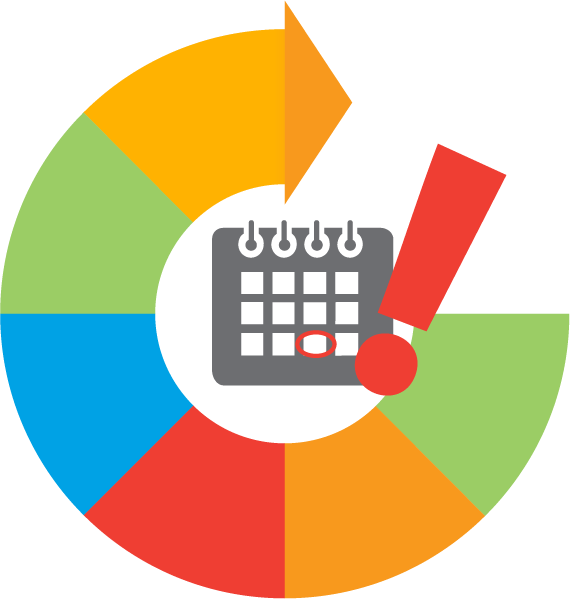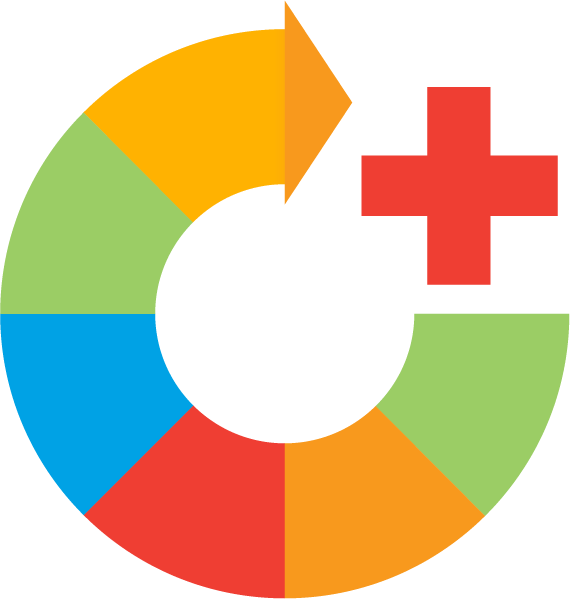You may already have read my “pontification” about the importance of using lists, schedules, and calendars. If you didn’t, I argued that using lists, schedules, and calendars is a relatively straightforward way of not only increasing your grades, but also decreasing the stress you’d be dealing with if you were always having to finish assignments and study for tests in last-minute rushes. Scheduling your time well is one of the simplest and most effective strategies to achieving success at college!
But how can we schedule our time well?
Using Calendars
When I think about time management, I think about the nature of time as a dimension. As humans, we exist in a four-dimensional space-time. Three of these four dimensions are very accessible to our sensory perception. I can look to the left and the right, I can look up and down, and I can look forwards and backwards, and in every direction, I see the world stretching out before me. If I’m walking towards an obstacle, I can see the obstacle and I can change course to walk around it.
I can’t perceive time this way. I can’t look into the future or the past and see it stretching out ahead of me. I can’t directly observe obstacles ahead and prepare for them.
Instead of perceiving the future, we prospect into the future. We use prospection to imagine what the future might be like, and then we can use these imaginings to prepare for the future. But this imagining is all happening in your mind! In a college setting, where there are a lot of things to imagine and prepare for over the course of a semester, it’s easy to overtax your prospective abilities and forget something. (And it certainly doesn’t help matters that there’s a part of us that wants to forget so we can go and do fun things instead of studying…)

To help our poor overwhelmed prospective mind, we need to convert time into a dimension we can easily perceive: a spatial dimension. This is what a calendar does. Suddenly, with a calendar, we can clearly see the obstacles and barriers ahead of us: obstacles and barriers that had previously existed only as dim ideas in our prospective imaginings.
At the beginning of the semester, in each of your college classes, you should receive a syllabus. This document will contain a list of all the assignments you’ll be asked to complete as part of the course. As soon as you have the syllabus, you should read it. Look for all the information about assignments. When is each assignment due? How much of your grade is it worth? Look at the requirements of the assignment – are there any intermediate steps?
As you gather this information, you can copy it onto some kind of calendar that allows you to visually see the semester sweeping ahead of you. This could be a nice big physical wall calendar, or it could be an app like Google Calendar that allows you to zoom out to a monthly view. I suppose you could even use something a little different, like a visual timeline, as long as it visually shows you that broad sweep of time.
When you copy the assignments, make sure to give yourself a sense of how important the assignment is. When you add each assignment to the calendar, include a note indicating what percentage of your grade it represents, and do something to highlight the biggest assignments.
If you like, I suppose you could also add readings to your calendar (or timeline), although you don’t want to make it too crowded.
Once you are finished with your calendar (or timeline), you’ll be able to see the semester unfolding ahead of you. For example, you might suddenly be able to see clearly that Week 7 has three midterms right after one another, and that you had better start studying well in advance to avoid a last-minute rush. You’ll be able to see that the really big term paper in such-and-such a class is coming up in a few weeks, and that you really ought to be starting your research for the paper so that you aren’t rushing to come up with a topic idea later. You won’t be accidentally overlooking obstacles, and you won’t be able to trick yourself into forgetting them either.
But even if we can see the work ahead of us, how do we hold ourselves to account and make sure that we do our work on a day-to-day basis? Even if we can’t deny that the obstacles in the future exist when we are actually looking at the calendar, it’s very easy to get distracted. To hold ourselves accountable on a daily basis, we need another tool.

Using Lists and Schedules
To hold ourselves to account, we need to break down this giant calendar (or timeline) and give ourselves smaller day-to-day goals. We don’t want to do this at the beginning of the semester, because new things we hadn’t anticipated will “come up” and we don’t want to be constantly modifying and redoing our daily schedules and to-do lists, but we can plan out the days immediately ahead of us.
We can take the grand calendar with the entire semester and supplement it with a daily schedule. This daily schedule doesn’t just have to show your studying, but can also show you when you have to be in class, when you have to be volunteering or working, or any other commitments on your time. This will not only remind us when we have to be going to places, but it also tells us how much time we will have available to study.
There are many different day-to-day schedules we could try. We could use a calendar app, like Google Calendar. (I don’t think you want to clutter up your grand calendar and daily schedule by mixing them together, but Google Calendar should allow you to create additional calendars, so you could keep them separate.) You could also use a weekly or daily timetable from a schedule book. I sometimes use the low-tech option of writing to-do lists in a Word document, which can be effective, although it has the disadvantage of not visually showing how much time each commitment will consume over the day.

Whatever tool you choose, you can use it to write down daily goals. For example, on the particular day I am writing this post, I have the following daily goals: write the post you are reading now, pick up a couple of books at the library, attend three meetings, finish some graphs I’m preparing for an analysis, send some emails, do a logistic regression analysis (don’t ask), and download some articles. Should you fail to complete all of your daily goals, you can simply move any incomplete goals to the following day. (If you start to get a giant pile-up of incomplete goals, that’s bad: you’re falling behind.)
Giving yourself daily goals like this also allows you to hold yourself to account. Think of some rewards you can give yourself for good behavior, and if you finish everything you planned in a day, reward yourself! If you have a good and legitimate reason for not finishing everything, reward yourself for your effort. One good reward can be leisure computer time. (You might also try rewards on a shorter timeframe, like 10 minutes leisure computing for every 50 minutes of studying.)
Setting Goals
But how do we set our goals in the first place? Well, that’s where the grand calendar comes in. We can generate our daily goals by looking at the grand calendar, reminding ourselves of the work that lies before us, and determining what we need to do today in order to finish our work on time. That means figuring out how long it will take to finish each of the tasks ahead of us and starting our work early enough that we will finish by the due date.
Unfortunately, humans aren’t good goal generators. There’s something called the “planning fallacy”: we underestimate how long we need to get stuff done (Buehler et al., 1994). It’s a known psychological phenomenon. You see, we can easily forget about some step or another in a project, or we can fail to anticipate some complications that will end up arising. We can also forget that we need to spend time doing things like eating, errands, and so forth. As a result, we invariably end up taking longer to get things done than we assumed, and we can have last-minute rushes.
How, then, do we accurately estimate how long it will take to do something?
Well, the best approach is to think of something similar you did in the past and remember how long that similar thing took. If the two projects are more or less equivalent, then it’s reasonable to assume the current project will take about as long as the previous one did. Again, I repeat: this analogical method is the most reliable way of estimating how long it will take to complete most tasks.

If you don’t have any similar examples to draw on yet, you can try guessing, but it’s good to make it a conservative guess. Add on some extra time to deal with unanticipated problems.
Here’s one resource you shouldn’t rely on too much when estimating how long a task will take: other students. Don’t trust other students if they tell you not to worry about a project yet. It’s quite likely that they should already be doing the project and that they’ll end up having a stressful last-minute rush.
You might also hear the general rule that you should spend two or three hours studying for each hour you spend in lecture. This is probably true on average, but I wouldn’t necessarily try to apply this to specific contexts. The amount of time you should be studying will depend a lot on the general demands of the class relative to other classes, the amount of background knowledge you have about the material, and whether you have any specific projects or tests coming up in the class.

Of course, when you’re guessing how long it will take to do something, you’ll have to take into account the nature of the project. Readings are pretty straightforward: you read them around the time that the instructor assigned them, and you can get a sense of how long it will take from the page count, the density of the text, etc. (But I do have a confession to make here: If I wouldn’t be quizzed on a reading in class, I would sometimes do the reading after class instead of before class, since it can sometimes be easier to understand the reading after hearing the instructor speak about it.)
Studying is a bit more complicated. (Look for my upcoming post on effective studying; you might want to read it.) Generally, you want to understand the concepts behind the material. You don’t want to study by memorizing a bunch of random facts. You also want to spread out your studying, because having a bunch of shorter, well-spaced-out practice sessions results in better learning than having a long last-minute cramming session (Cepeda et al., 2006).
Finally, when it comes to papers and larger projects, the paper’s required length and its proportion of your final grade will tell you something about the amount of time you’ll need to spend on it. Even after you block off time for researching and draft-writing, you will still want to leave lots of time for review and revision. Not only is it a good idea to spend about as much time editing and revising your paper as you did writing the initial draft, but you’ll want to leave gaps between writing and revision, so you can approach the draft again with fresh eyes. (Here are some other hints about papers: if you are choosing a topic for your paper, go to office hours and discuss the topic with your instructor. Also, unless you have a take-home exam, you are usually allowed to ask other people for feedback on your paper.)
This sounds like a lot of information, I know, but once you’ve been at college for a while, it will get easier to accurately calculate how early you should start working on any given project. This is partly due to the reliability of that analogical estimation method: the reliability of estimating how long things will take based on how long similar things have taken before. As you gain college experience, you’ll have more past projects to draw on.
Putting it All Together

Now, once you have an idea of approximately how long a given task or project will take, you can look at your grand calendar, see the task or project approaching, and generate goals to ensure that you have it done in time. Each time you meet a goal, cross it off your list. Crossing tasks off a list can be a very satisfying feeling. And whenever you finish all your tasks on time, give yourself a reward.
If you adopt this approach and implement it well, you will not only find yourself avoiding last-minute rushes and doing better on your assignments, but you’ll also find yourself avoiding the stress and anxiety that comes along with those last-minute rushes. You’ll be able to sleep soundly knowing that you have everything under control.
Have you tried using this approach – and if so, how did it go? Do you use a different approach? Questions? Please share your thoughts in the comments section below!
References
Buehler, R., Griffin, D., & Ross, M. (1994). Exploring the ‘planning fallacy’: Why people underestimate their task completion times. Journal of Personality and Social Psychology, 67(3), 366-381. http://doi.org/10.1037/0022-3514.67.3.366
Cepeda, N. J., Pashler, H., Vul, E., Wixted, J. T., & Rohrer, D. (2006). Distributed practice in verbal recall tasks: A review and quantitative synthesis. Psychological Bulletin, 132(3), 354-380. http://doi.org/10.1037/0033-2909.132.3.354






1 Comment